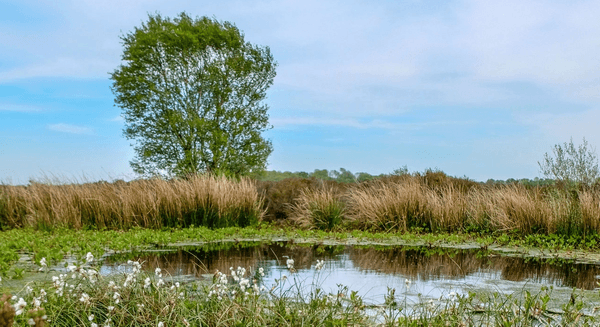Design & Nature Reimagined: The beauty of bogs
Peat bogs, also called peatlands, are huge, HUGE natural carbon sinks; that's a good thing! A carbon sink is an area where carbon dioxide (CO2) settles, and it stays out of the atmosphere. Peatlands are a type of wetland, and altogether they hold twice as much carbon as all the world's forests! Peatlands are often harvested or burned for commercial and agricultural use. Rice paddy fields are a common agricultural use and buying planting soil with peat moss or sphagnum moss is a very common way that we individually contribute to this. So, if you live in the US or Canada and you're planning to garden this year, I'm asking you to choose soils without peat moss or sphagnum peat moss. You can either check the soil details or ask a garden center employee to help you.
The UK is still (slowly) phasing out the use of peat moss in home gardening products, so if you're working on a garden in that area, it will likely be much easier to find peat free alternatives. Potting soils with coconut coir or worm castings are a good alternative. Additionally, you can always buy separate worm castings and use it as an additive to your existing soil rather than buying something off the shelf from the garden center. **Okay, so what new and exciting things are happening in the world of peat? **Right now, it seems like growing awareness is key to reducing our current use of peat and restoring these habitats.
Improving on a 400 year old industry
Estonia has started peat bog restoration in order to fight climate change and provide habitat for wildlife. It wants to restore 50,000 acres at 89 bogs. Peat bogs have been harvested in Estonia for 400 years (and in Ireland for over 1,000 years), so this industry is long overdue for a shake-up.
Right now, the first change is a new requirement that peat bogs must be restored after harvesting. It can take several years to recover, so a better option is not to harvest it from the start. Consequently, Estonia is one of the most tech-savvy countries in the world, so I expect lots of nature collaborations and innovations from there in the near future.
Mapping our peatlands
Because peatland occurs in many climactic zones (from tropic to arctic regions), it's important that we get a baseline of how many bogs there are. We can't improve what we can't measure. So, in addition to field tracking, such as sending a scientist out into a field to map the area, scientists are also using satellite data to detect and measure peatlands. This allows them to create more comprehensive maps in areas that are hard to reach.
And speaking of maps
This neat map from Stony Brook university lets you look at some of the peatlands around the world! This mapping project also does a short deep dive into specific peat lands and their history. Global Forest Watch also has data on select peatlands around the world, too, if you want to see what a more open data set looks like.
Now that you've read about peat moss, let's get a look at it! Here's a peat bog for you.
You can learn more about peat bogs, and see some beautiful pictures here.

